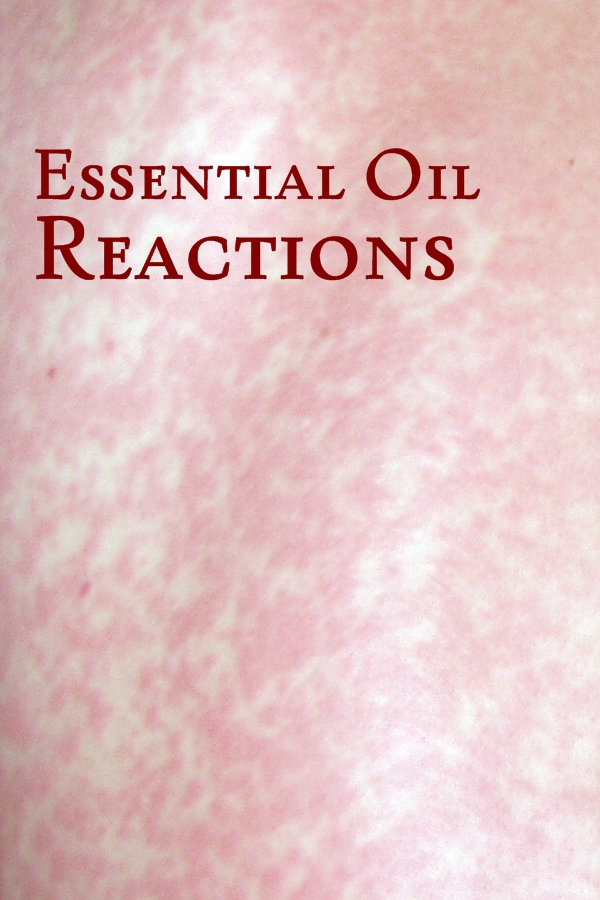We talk about essential oil safe practices for a reason — negative reactions can and do happen. As I’ve mentioned before, they should be kept in perspective. Life-threatening reactions are extremely rare, and even serious non-life-threatening reactions are not that common if proper dilution and similar practices are adhered to. But that’s a really good reason not to throw caution out the window — so you can enjoy the use of essential oils for years to come!
The three most common risks of essential oils are irritation, photosensitivity, and sensitization.
Irritation
Irritation is a surface-level reaction to an essential oil. Probably most of us are familiar with irritation, in general terms: some substance comes into contact with the skin, the skin doesn’t like it, and it responds with inflammation: redness, possibly itching or “burning,” etc.
With irritation, there is generally a clear and obvious connection between the application of the essential oil and the reaction. Usually it’s fairly minor (although severe irritation reactions are possible), and it should begin to dissipate as soon as the offending oil is removed. Irritation is more likely to occur if you have sensitive skin and/or with “hot” oils or other known irritant oils.
Proper dilution should vastly reduce the chances of experiencing irritation from essential oils*. If an oil does irritate, wash it off immediately. Rubbing some extra carrier oil into the irritated skin may help to soothe it more quickly.
*Most of the severe irritation reactions I’ve seen have been a result of trusting a company’s “prediluted” oils to be sufficiently diluted. Unless the bottle specifies the dilution rate, don’t trust it. Dilute it again yourself.
Photosensitivity
Photosensitivity is a specific concern with a particular handful of essential oils (and it doesn’t have to be a concern at all if you know what they are and use them properly). Like some pharmaceuticals, certain essential oils amplify the effects of the sun (and other UV rays) on the skin. That means sunburn and related sun damage happen very quickly in this context.
Avoiding this issue is pretty simple, though. Don’t apply photosensitizing oils topically to exposed skin, within about 12-24 hours before going into the sun (or visiting a tanning bed, etc.). You have a few different options. Apply the oil to skin that will be covered. Wait at least 12 hours after application before heading into the sun. Don’t use the oil. Or choose a non-topical method of administration (diffuse it, for example).
Of the essential oils that are in common use among non-professionals, the citrus oils are the primary offenders. Bergamot is one of the worst. Expressed sweet orange oil is said to not be photosensitizing. (Steam-distilled is, but steam-distilled citrus oils are uncommon.) Most other citrus oils are photosensitizing to one degree or another. The only other two oils in relatively common use that I’m aware may fall into this category are angelica and clary sage**.
**My textbooks claim that clary sage is photosensitizing, but I have not been able to confirm that with other sources, so I suspect it may be a typo.
Sensitization
Sensitization may appear, on the surface, to be similar to irritation. However, sensitization, rather than being a direct contact reaction like irritation, is a systemic reaction, mediated by the immune system, like an allergy. For this reason, the cause-and-effect may be less obvious, and sensitization rarely, if ever, occurs upon the first use of an oil.
This may be a reaction that occurs the second or third time a given oil is used, or it may develop over time. That’s one reason it’s so very important to use good practices with young children! They may not have any reaction now to harsh oils used undiluted, but that sort of use is far more likely than careful use to create a sensitization over time that will prevent them from being able to use the oils later.
What happens with sensitization is that the oil makes it way into the bloodstream and then antibodies are created. Upon a future application, that immune response kicks in. Because it’s a systemic reaction, the symptoms may appear systemic, but they usually do not. They usually are fairly similar to irritation, in actual appearance.
If sensitization occurs, it is likely that oil will never be able to be used again without producing a negative reaction. Of course discontinue use of the oil if a reaction occurs. Then treat the reaction in whatever way is appropriate: topical application of soothing substances to help calm the skin, antihistamines (pharmaceutical or herbal) to help combat the overall response. And of course in the unlikely event of an anaphylactic reaction, get emergency assistance immediately. (I have never heard of this happening, but it is theoretically possible.)
Some essential oils can cross-react with other substances, so if you’re already allergic to a given plant or its close relative, be especially vigilant to watch for reactions. (Not all elements of a plant are present in the essential oil, though, so an allergy to the plant does not necessarily mean one will react to the oil.)
Don’t Panic
I know a focus like this on “everything that can go wrong” has the potential to be fear-inducing but, as I’ve said before, don’t panic. Education is often the best prevention, and really serious reactions are not especially common. Know what you’re watching for, and know how to handle unpleasant situations if they should arise, and you can move forward with confidence.
I am not a licensed medical practitioner, and nothing in this post should be construed as diagnosing, treating, preventing, or curing any illness. This information is provided for educational purposes only.

Leave a Reply